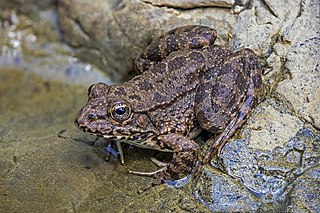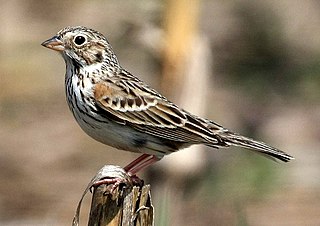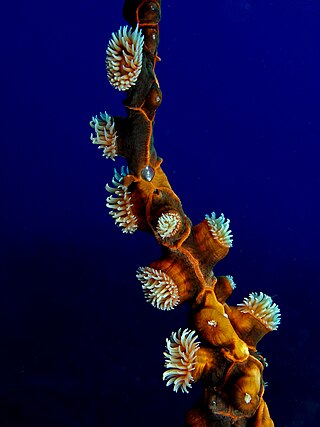
Order Desmothoracida, the desmothoracids, are a group of heliozoan protists, usually sessile and found in freshwater environments. The adult is a spherical cell around 10-20 μm in diameter surrounded by a perforated organic lorica, or shell, with many radial pseudopods projecting through the holes to capture food. These are supported by small bundles of microtubules that arise near a point on the nuclear membrane. Unlike other heliozoans, the microtubules are not in any regular geometric array, there does not appear to be a microtubule organizing center, and there is no distinction between the outer and inner cytoplasm.
Genus is a taxonomic rank used in the biological classification of living and fossil organisms as well as viruses. In the hierarchy of biological classification, genus comes above species and below family. In binomial nomenclature, the genus name forms the first part of the binomial species name for each species within the genus.

True frogs is the common name for the frog family Ranidae. They have the widest distribution of any frog family. They are abundant throughout most of the world, occurring on all continents except Antarctica. The true frogs are present in North America, northern South America, Europe, Africa, and Asia. The Asian range extends across the East Indies to New Guinea and a single species, the Australian wood frog, has spread into the far north of Australia.

The vesper sparrow is a medium-sized New World sparrow. The only member of the genus Pooecetes, it is a pale sparrow with brown streaks that breeds across the grasslands of northern North America. It migrates to winter in the southern United States and Mexico.

Ommastrephidae is a family of squid containing three subfamilies, 11 genera, and over 20 species. They are widely distributed globally and are extensively fished for food. One species, Todarodes pacificus, comprised around half of the world's cephalopod catch annually.

Ruppia, also known as the widgeonweeds, ditch grasses or widgeon grass, is the only extant genus in the family Ruppiaceae, with eight known species. These are aquatic plants widespread over much of the world. The genus name honours Heinrich Bernhard Rupp, a German botanist (1688-1719). They are widespread outside of frigid zones and the tropics.

Zoanthids are an order of cnidarians commonly found in coral reefs, the deep sea and many other marine environments around the world. These animals come in a variety of different colonizing formations and in numerous different colors. They can be found as individual polyps, attached by a fleshy stolon or a mat that can be created from small pieces of sediment, sand and rock. The term "zoanthid" refers to all animals within this order Zoantharia, and should not be confused with "Zoanthus", which is one genus within Zoantharia.

Psephotellus is a genus of medium sized Australian parrots. Four species found across the country are recognised, one is presumed to have become extinct.

Bamboo partridges, sometimes called ridge partridges, are medium-sized non-migratory birds of the genus Bambusicola in the family Phasianidae.They have a wide native distribution throughout Asia. They were formerly grouped in the Perdicinae subfamily of the Phasianidae. However, molecular research suggests that partridges are not a distinct taxon within the family Phasianidae, but that some species are closer to the pheasants, while others are closer to the junglefowl. Phylogenetic evidence supports the bamboo partridges as being the sister genus to the junglefowl.

Glyphoglossus is a genus of frogs in the family Microhylidae. The genus occurs in Southeastern Asia. Common name balloon frogs has been coined for it, whereas the common name squat frogs refers to the Calluella species that are now included in this genus. They are fossorial frogs that spend only limited time on the soil surface and are typically known from only few specimens.
Sphenopus, is a genus of Asian and Mediterranean plants in the grass family.

Amphianthus is a genus of sea anemones. It is the only genus in the monotypic family Amphianthidae.

Bunodactis is a genus of sea anemones in the family Actiniidae.

Sphenopidae is a family of cnidarians.

Liponema is a genus of sea anemones, in the family Liponematidae.

Myriotrochus is a genus of sea cucumbers. The following species are recognised in the genus Myriotrochus:
Loliolus is a genus of squid from the family Loliginidae from the Indo-Pacific region. The genus is divided into two subgenera Loliolus and Nipponololigo. They are small squids of less than 150 mm (5.9 in) in mantle length which have an expanded tentacular club. This club has 4 series of suckers. The sucker rings have plate-like teeth which are square in shape all around them. The males' hectocotylus has a ventral crest which is created by the fusion of the protective membrane with the ventral series of papillae and this crest completely obscures the conical shape of the papillae. The mantle is rounded posteriorly and lacks the posterior tail-like lobe while the fins are positioned on the rear of the mantle and extend to the posterior tip of the mantle. Their eggs are small and the males' spermatophore has a short cement body. They do not possess photophores. The two subgenera are distinguished by the hectocotylus which in Loliolus encompasses the entire arm and there are no unmodified suckers while in Nipponololigo the arm is only partly hectocotylsed and has normal suckers at its base.
Tanypleurus is a monotypic genus of crustaceans belonging to the monotypic family Tanypleuridae. The only species is Tanypleurus alcicornis.
Ophiodiscus is a genus of cnidarians belonging to the family Actinostolidae.
Sphenopus divaricatus is a species of grass in the family Poaceae.














